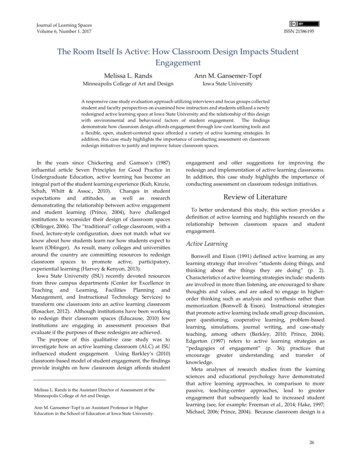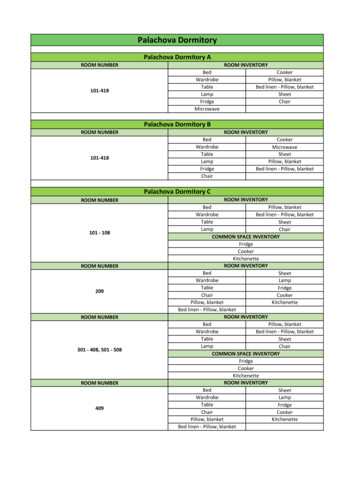
Transcription
Journal of Learning SpacesVolume 6, Number 1. 2017ISSN 21586195The Room Itself Is Active: How Classroom Design Impacts StudentEngagementMelissa L. RandsAnn M. Gansemer-TopfMinneapolis College of Art and DesignIowa State UniversityA responsive case study evaluation approach utilizing interviews and focus groups collectedstudent and faculty perspectives on examined how instructors and students utilized a newlyredesigned active learning space at Iowa State University and the relationship of this designwith environmental and behavioral factors of student engagement. The findingsdemonstrate how classroom design affords engagement through low-cost learning tools anda flexible, open, student-centered space afforded a variety of active learning strategies. Inaddition, this case study highlights the importance of conducting assessment on classroomredesign initiatives to justify and improve future classroom spaces.In the years since Chickering and Gamson’s (1987)influential article Seven Principles for Good Practice inUndergraduate Education, active learning has become anintegral part of the student learning experience (Kuh, Kinzie,Schuh, Whitt & Assoc., 2010).Changes in studentexpectations and attitudes, as well as researchdemonstrating the relationship between active engagementand student learning (Prince, 2004), have challengedinstitutions to reconsider their design of classroom spaces(Oblinger, 2006). The “traditional” college classroom, with afixed, lecture-style configuration, does not match what weknow about how students learn nor how students expect tolearn (Oblinger). As result, many colleges and universitiesaround the country are committing resources to redesignclassroom spaces to promote active, participatory,experiential learning (Harvey & Kenyon, 2013).Iowa State University (ISU) recently devoted resourcesfrom three campus departments (Center for Excellence inTeaching and Learning, Facilities Planning andManagement, and Instructional Technology Services) totransform one classroom into an active learning classroom(Rosacker, 2012). Although institutions have been workingto redesign their classroom spaces (Educause, 2010) fewinstitutions are engaging in assessment processes thatevaluate if the purposes of these redesigns are achieved.The purpose of this qualitative case study was toinvestigate how an active learning classroom (ALC) at ISUinfluenced student engagement. Using Barkley’s (2010)classroom-based model of student engagement, the findingsprovide insights on how classroom design affords studentMelissa L. Rands is the Assistant Director of Assessment at theMinneapolis College of Art and Design.Ann M. Gansemer-Topf is an Assistant Professor in HigherEducation in the School of Education at Iowa State University.engagement and offer suggestions for improving theredesign and implementation of active learning classrooms.In addition, this case study highlights the importance ofconducting assessment on classroom redesign initiatives.Review of LiteratureTo better understand this study, this section provides adefinition of active learning and highlights research on therelationship between classroom spaces and studentengagement.Active LearningBonwell and Eison (1991) defined active learning as anylearning strategy that involves “students doing things, andthinking about the things they are doing” (p. 2).Characteristics of active learning strategies include: studentsare involved in more than listening, are encouraged to sharethoughts and values, and are asked to engage in higherorder thinking such as analysis and synthesis rather thanmemorization (Bonwell & Eison). Instructional strategiesthat promote active learning include small group discussion,peer questioning, cooperative learning, problem-basedlearning, simulations, journal writing, and case-studyteaching, among others (Barkley, 2010; Prince, 2004).Edgerton (1997) refers to active learning strategies as“pedagogies of engagement” (p. 36); practices thatencourage greater understanding and transfer ofknowledge.Meta analyses of research studies from the learningsciences and educational psychology have demonstratedthat active learning approaches, in comparison to morepassive, teaching-center approaches, lead to greaterengagement that subsequently lead to increased studentlearning (see, for example: Freeman et al., 2014; Hake, 1997;Michael, 2006; Prince, 2004). Because classroom design is a26
THE ROOM ITSELF IS ACTIVE: HOW CLASSROOM DESIGN IMPACTS STUDENT ENGAGEMENTsignificant factor that can either hinder or promote thisengagement, this study examined the relationship ofclassroom design and engagement.Classroom Space and its Effect on EngagementMohanan (2002; 2000) refers to classroom design as “builtpedagogy”, or the design of the classroom space is a physicalmanifestation of educational theories, philosophies, andvalues.He states, “Given the premise that builtenvironments enable and constrain certain modes of socialaction and interaction, educational structures embodycurricula and values by design (2000; p. 1).”Within a classroom design, constructs known asaffordances are created that enable or constrain engagement.An affordance refers to the perceived and actual propertiesof objects or environments that determine how the object orenvironment could be used (Gibson, 1979; Norman, 2002).Affordances are resources within an environment to thosewho perceive and use them (Norman). For example,movable chairs afford students the ability to group closertogether for collaborative work or discussion. Within thecontext of this study, it is assumed that the designed,physical environment of the ALC provides affordances forlearning behaviors and pedagogical practices that supportstudent engagement in the learning process.Previous research has investigated classroom design andits relationship with student learning, including the effect ofopen learning spaces (Barber, 2006; Graetz & Goliber, 2002;Hunley and Schaller, 2006), flexible seating and writingsurfaces (Lombardi and Wall, 2006; Sanders, 2013), theintegration of technological learning tools (Brewe, Kramer,& O’Brien, 2009; Educause, 2012; Sidall, 2006; Whiteside &Fitzgerald, 2005), lighting (Sleeters, Molenaar, Galetzka, &van der Zanden, 2012), and aesthetics (Janowska & Atlay,2007). The richness of studies such as these illustrate howclassroom affordances can positively support classroompractices by enhancing student engagement in the learningprocess.Through the lens of a classroom-based model of studentengagement in one redesigned active learning classroom atISU, this study contributes to the literature by providingunderstanding of how the designed environment affordslearning behaviors and teaching practices that promotestudent engagement in learning.Theoretical FrameworkBarkley’s (2010) classroom-based model of studentengagement provides the theoretical framework for thisstudy. Barkley defines student engagement as “a processand a product that is experienced on a continuum andresults from the synergistic interaction between motivationand active learning” (p. 8). Barkley states classroomsenvironments create synergy between active learning andmotivation by (a) “creating a sense of classroomcommunity”, (b) “helping students work at their optimallevel of challenge”, and (c) “teaching so that students learnholistically” (pp. 24-38). Therefore, attention was paid tohow the classroom design affords behaviors and conditionsthat promote student engagement.MethodsThis qualitative case study assessment is a theoreticallybased, utilization-focused cross-sectional design thatcollected data on classroom use and perceived effectiveness(Fitzpatrick, Sanders, & Worthen, 2011). The study wasapproved by the Institutional Review Board.Figure 1: ALC Before and After. ALC prior to redesign (left) and after (right). In the redesigned classroom image, the movablechairs are arranged in small group format; portable white boards are placed on the chairs to be used as table tops for smallgroup work. Copyright 2014 Iowa State University. Reprinted with permission.Journal of Learning Spaces, 6(1), 2017.27
THE ROOM ITSELF IS ACTIVE: HOW CLASSROOM DESIGN IMPACTS STUDENT ENGAGEMENTFigure 2: Three Views of ALC. Three views of the redesigned ALC. Left image: the classroom in small group format, from front ofthe room. Middle image: small group format from the rear of the room. Right image: row seating format from the front of the room.Copyright 2014 Iowa State University. Reprinted with permission.The study focused on a classroom at ISU that wasredesigned from a ‘traditional’ classroom, with a fixedseating configuration and no classroom technology, into to aflexible layout and seating configurations and addedtechnology to enhance student learning. The ALC wasdesigned specifically for active, collaborative learningincluding portable white boards, supplemental computermonitors, and flexible seating to accommodate small group,large group, and individual work. The classroom has amaximum capacity of 36 students. Figure 1 shows theclassroom before and after redesign, and Figure 2 showsthree views of the new ALC.ParticipantsFaculty and students who had taught or taken at least onecourse in the ALC in spring 2013, fall 2013 and/or spring2014 semesters were participants. Four instructors and ninestudents participated in the study. Although the sample sizewas small, the participants represented a variety ofdisciplines which allowed for maximum variation: the goalwas to identify common patterns among diverse classroomexperiences (Marshall & Rossman, 1999).Data CollectionData was collected via focus groups. The social, semipublic nature of a focus group method allowed for multipleviews and perspectives aimed at gaining insight into theattitudes, feelings, and beliefs of classroom users (Morgan,1998). All participants were offered the opportunity forprivate interviews in lieu of participating in focus groups;one faculty member opted for an individual interview forthis reason.Data from faculty members were collected in one focusgroup and one individual interview. Faculty were askedJournal of Learning Spaces, 6(1), 2017.semi-structured interview questions regarding theirinteractions with students, to reflect upon specific examplesof incorporating the physical attributes of the classroom intheir lessons, and their perceptions on students’engagement. Data were collected from students via threefocus groups. Students were asked semi-structuredquestions regarding their interaction with others, with thephysical and technological attributes of the classroom, andtheir perceptions of their own motivation and engagement.All focus groups and interviews were recorded andtranscribed for analysis.Data AnalysisData from the transcripts were analyzed using a twocycle method of coding and analysis (Saldaña, 2009). In thefirst phase, descriptive codes were used to highlightconcepts or contents representing references to activelearning and motivation, reflection, and self-monitoring oflearning; attribute codes were used to identify data relatingto attributes of the classroom design, and descriptive codesidentified the affordances the space provided. Value codeshighlighted participants’ descriptions of participants’values, attitudes, and beliefs (Saldaña). In the second phase,clusters of data were formed around Barkley’s (2010)description of classroom conditions that promote studentengagement; these clusters included the descriptive,attribute, and value codes.Multiple strategies were used to ensure goodness andtrustworthiness (Merriam, 2002). Participants reviewedfocus group and interview transcripts to ensure theparticipants’ thoughts and beliefs were adequately captured(Merriam). Analytic memos and other documentation werekept as an account of the methodological procedures(Saldaña, 2009).Finally, descriptions of context andparticipant narratives provide illustrations of the themes for28
THE ROOM ITSELF IS ACTIVE: HOW CLASSROOM DESIGN IMPACTS STUDENT ENGAGEMENTthe reader to consider transferability to other contexts(Merriam).ResultsThe purpose of this study was to examine how thephysical design of the ALC impacted student engagement.Three themes emerged: (a) the classroom design created acommunity of learners, (b) classroom design helpedstudents work at their optimal level of challenge, and (c)classroom design helped students to learn holistically.Classroom Design Creates a Community of LearnersThe ALC is a flexible, open classroom design; studentseating is not fixed, and there are no stationary tables orwork spaces. These features afforded the classroom space tobe adapted to support different instructional strategies.Participants reported the flexibility of the design affords forstudents and instructors to move around the classroomenabling social interaction and collaboration. Students feltthat the classroom design “erased the line” betweeninstructors and students which encouraged interaction andled students to feel closer personal connections with theirinstructor and their peers, creating a sense of communityand enhancing student engagement.Open Space Affords Movement and Interaction. Theflexible, open design of the ALC afforded student andinstructor movement, and intellectual and social interaction,in the classroom. The mobile chairs/desks enabled studentsto interact with other students in order to ask questions andclear up misunderstandings. A student said, “Even if ourgroup didn't know [the answer to a question], we would likeswing around and join up with another group that reallyhelped, being able to open up a connection.” A facultymember illustrated how she felt the movable chairs in theALC helped students “hear each other” more.Shecontinued:These people will be here and these folks, and they're alltalking about the same thing, but these folks will hear[the discussion] and kind of respond to it becausethey're close there's this moment when [theknowledge] moved across the room which is veryexciting” everything about this room really enabledthat kind of outcome.“Erasing the Line” Affords Distributed Knowledge.Classroom design made students feel valued as coconstructors of knowledge, due to the design of the ALC“erasing the line” between students and instructors. “Theline” in traditional classrooms was described as “theseparation between students and teacher; a solid linebetween where they stand and you sit.” The design of theALC removed the dedicated instructor space at the front ofthe room encouraging social interaction between instructorsJournal of Learning Spaces, 6(1), 2017.and students.The “line” was also described as apsychological separation between themselves and theirinstructors; removing this line resulted in an environmentwhere students felt respected and valued.Instructors mentioned they felt they moved around theclassroom and engaged in discussions with students morefrequently in the ALC as compared to other traditionalclassrooms. Students also stated their instructors oftenmoved freely around the classroom, allowing them directcontact with their instructors. A student said he felt thefrequent movement by the instructor around the classroomcollectively increased the engagement of his classmates bymaking them feel more comfortable and active. “Somethingabout [the design] makes everybody, probably the studentsand professor, more comfortable and able to really engagewith what's going on in the classroom,” he said.Students felt that the frequent student-faculty interactionin the ALC made them feel valued. A student compared hisinstructor’s approach in the ALC as more as a facilitator ofstudent learning than an instructor:In [the ALC], where everything is flat, and open, andspread out uniformly, the focus is distributed across theentire classroom across all of the students andinstructor, this professor is one of us. He’s there becausehe’s trying to facilitate our learning.A faculty member for whom “building community oflearners” was a learning outcome, stated the flexibility of theroom’s design supported this outcome by allowingeveryone, instructors and students, to move freely andengage with diverse others. This instructor felt the level towhich this outcome had been reached was higher for hisclass in the ALC than in other classrooms in which he hadpreviously taught the course.In summary, the flexible, open design of the ALC allowedfor movement within the classroom, encouraging socialinteraction among peers and students and instructors.Participants reported that frequent social interaction enabledstudents to connect with each other and their instructor toshare, distribute, and co-construct knowledge, resulting in afeeling of community and engagement.Classroom Design Helps Students Work at theirOptimal Level of ChallengeVarious audiovisual tools in the ALC increasedengagement by helping students to work at their optimallevel of challenge. Tools such as portable white boards,Apple TV, LCD panel video projectors, the large writingsurface, and flat panel monitors placed around theclassroom afforded frequent assessment of students’understanding and for students to create and shareknowledge. Students could measure and monitor their own29
THE ROOM ITSELF IS ACTIVE: HOW CLASSROOM DESIGN IMPACTS STUDENT ENGAGEMENTlearning increasing their engagement in the learningprocess.Tools Afford Assessing for Understanding. Facultystated they frequently used the audiovisual tools in the roomto check for students’ understanding. Faculty membersreported they used the portable white boards in the ALC for“report backs” from application activities. One studentmentioned the use of the white boards for small groupreporting in his course, remarking the boards increased theease and speed of being able to report back to the instructoror class. “We would all be given the same problem. Thegroups afterward would compare answers, talk about howwe got there .and use [the portable white board] to postour answer,” he said. A faculty member also spoke aboutusing the monitors placed around the room for assessment;students would text in responses to a question and theinstructor would present the answers in word cloud as aclassroom assessment technique. Participants stated theaudio visual tools facilitated rapid, frequent assessment ofunderstanding to students could measure and monitor theirown learning.Tools Afford Visualizing Thinking. The incorporationof audiovisual tools also allowed for students to make theirthinking and ideas visible to the instructor and their peers.One student illustrated how the portable white boardshelped make their understanding visible to peers andprovided a large workspace for working through ideas,making revisions, and visually demonstrating a hierarchy ofinformation. Students also stated that being able to seeinformation presented in multiple ways through theaudiovisual tools helped them retain information. “You seeit at least three times [in three different ways], so that helpsit stay in your head,” one student stated.Participants commented on how graphically organizinginformation with the audiovisual tools helped them tomonitor their own learning. A faculty member felt that theportable white boards helped promote higher order thinkingskills in her course by integrating writing with groupdiscussion. One student stated her working group moved tothe ALC when it was not occupied specifically to use thewhite boards to study for another course. Diagramming andwriting out the various systems she needed to understandfor her course on separate, portable white boards andorganizing the them along the wall helped her and herclassmates fully understand the content at a deeper level:“[My course] is very complicated so it’d be nice to drawthings out it was nice to have the knowledge of knowinga place on campus that we can do something like that andreally utilize [it]”.The audiovisual tools in the ALC allowed faculty to assessstudent knowledge to check for understanding. The toolsalso encouraged students to share their knowledge withJournal of Learning Spaces, 6(1), 2017.their peers, co-create knowledge together, or monitor theirown understanding. Participants felt audiovisual toolsavailable in the ALC to promoted active and engagedlearning.Classroom Design Encourages Students to LearnHolisticallyParticipants frequently commented on how the ALC’sdesign was “active” in the sense that it engaged the mindand the body in learning. Many participants felt they werephysically active in the ALC; instructors felt they movedaround the room more, students moved to collaborate witheach other or demonstrate understanding. The learningtools in the ALC allowed for pedagogical options to engagestudents in many kinds of active learning strategies.Together, these conditions allowed for faculty to holisticallyengage students in learning.Design Affords Integrated Learning. Both faculty andstudents provided accounts of kinesthetic experiences oflearning in the ALC. One student commented on how themobility of the chairs enabled innovative instructionalstrategies that involved moving the whole class. “There wasone day [the instructor] did a debate we pushed the chairsaway and stood up, and actually straight-up divided theclassroom.” One instructor discussed an activity where hehad the class “step into the circle” to demonstrate theirunderstanding. “I used the entire room. I don't want themsitting. I love the space to be able to push chairs out andjust, the use of space.” He felt allowing them to move freelyaround the room to help students understand a concept at adeeper level by engaging their body as well as their mind.Another faculty member illustrated how she felt her class,which was predominantly male, was able to stay engagedbecause they could move. “I actually think that that washelping them focus because they didn't have to keepthemselves constricted by being able to physically relax inthat way, they actually were very focused.”Design Affords Pedagogical Options. Instructors spokeof their desire to integrate more modes of content deliveryand active learning strategies into their courses due to theopen design and learning tools in the ALC.Facultycollectively brainstormed how the audiovisual features inthe ALC could be used and expressed a desire to add morevisuals into their teaching to increase engagement andsupport active learning. Students also commented that theALC helped them stay engaged by envisioning ways theycould use the classroom to aid their own learning. Onestudent said “every time I walk into that room it’s alwayssomething new.” He then went on to explain how his visionfor “connected learning” in mathematics was based on thelearning tools available in the ALC.30
THE ROOM ITSELF IS ACTIVE: HOW CLASSROOM DESIGN IMPACTS STUDENT ENGAGEMENTDespite the positive feedback on the ALC, some facultyand staff found the classroom disorienting or distracting.Some students noted that because of the mobility of thechairs it the classroom was often “messy” or disorganized.One student stated that the lack of uniformity in the designwas distracting. One faculty member commented that shecouldn’t envision ways the monitors could be used to engagestudents in her class; others felt they weren’t “tech savvy”enough to use them. Although there were a few descriptionsof how the design of the ALC could distract students, theparticipants overwhelmingly felt the ALC contributed tostudent engagement.Previous research has identified that the physical learningspace affects a faculty member’s choice of pedagogicaloptions (Hunley & Schaller, 2006; Educause, 2010). Theresults of this study also found this to be true. The flexibleclassroom space facilitated the use of various studentengagement techniques and also inspired instructors andstudents with an array of pedagogical choices. Given theimportance of flexibility in classroom design, existing andfuture classroom spaces could be evaluated through theflexible properties of the space (Mohanan, 2002).DiscussionThe results of this study demonstrate various ways thephysical attributes of a classroom create affordances thatpromote student engagement. Mobile chairs affordedmovement, facilitating interpersonal communication andcollaboration between students. Portable whiteboardsafforded group work and allowed for rapid assessment ofunderstanding. These two features are low-cost, feasibleadditions to existing classrooms without requiringsubstantial physical redesign of the interior space. Theadditional monitors afforded increased visibility but werenot utilized due to assumptions made about user’s access toand comfort with the technology. Due to their high cost, isrecommended that classroom planners carefully considerthe addition of monitors to future classroom re-designs.Removal of the spatial barrier between instructors andstudents in the ALC’s design afforded student-facultyinteraction and motivated students to learn. Future designsthat locate the instructor space within the environment helpto increase student accountability and agency. Flexiblespaces that are adaptable to a variety of instructionalstrategies and approaches afforded the use of active learningstrategies, while the various learning tools available in theclassroom inspire instructors, and their students, with anarray of pedagogical choices. However, it is recommendedthat training on classroom technology and active learningstrategies are offered in conjunction with the physical redesign of classroom spaces. These findings offer suggestionsfor improving the redesign and implementation of futureactive learning classrooms.The findings of this study illustrate the classroom designcreated affordances which support learning behaviors andpedagogical practices for student engagement. Flexibilityand openness were key attributes in promoting acommunity of learners, and allowing students to learnholistically, encouraging student engagement in learning.Removing the spatial barrier between faculty and studentspace was an important classroom attribute that promotedstudent-faculty interaction and a place where students feltthey were co-constructors of knowledge. This findingconnects to previous assertions that active learning spacesrequire more accountability for learning by students due tothe few physical barriers between them and their instructors(Cotner, Loper, Walker, & Brooks, 2013; Hunley & Schaller,2006). Participants also frequently commented on howmobile they were during their classes; this mobility assistedin creating community and keeping class active anddynamic. Encouraging the movement of the instructor andstudents through the space to promote faculty-student andpeer-to-peer interaction influences student engagement.The study also found that audiovisual tools portunities to revisit content in different modes, andallowed for instructors to assess students understanding andfor students to monitor their own learning. Previousresearch has shown that the addition of technology andother visual tools in the classroom affords a greater sense ofengagement, and are integral to understanding of content(Brewe, Kramer, & O’Brien, 2009; Whiteside & Fitzgerald,2005), which leads to higher student achievement(Educause, 2010), Students retain more information if theyare using multiple senses to process information (Barkley,2010). An important finding in this study is that the lowercost features, such as portable whiteboards and movablechairs, appeared to provide the greatest affordances forlearning and student engagement; this finding is alsosupported by previous studies in other learning contexts(Brewe et al, 2009; Wise & Soneral as cited in Matthes, 2015).Journal of Learning Spaces, 6(1), 2017.Implications for Classroom DesignImplications for Assessing ALCsThis case study outlines an assessment of an ALC’s thatproduced valuable data to support current and futureclassroom redesign.Although the small number ofparticipants limits the generalizability of the findings tobroader contexts, this small scale assessment providesimportant insights into the role of ALCs in promotingstudent engagement. Future assessments that incorporatemore faculty and students may allow for a more nuanced31
THE ROOM ITSELF IS ACTIVE: HOW CLASSROOM DESIGN IMPACTS STUDENT ENGAGEMENTview of this phenomenon. Similarly, assessments couldevaluate how the influence of various strategies onsubpopulations of faculty and staff (i.e. gender, ethnicity,academic ability) and could also include a focus ondiscipline-specific contexts and/or content knowledge.Future assessments can also focus on direct measures ofstudent learning and performance by comparing students inan ALC classroom with students in “traditional” classrooms.These more complicated and time intensive inquiries canadd value to our understanding of ALC classrooms andother learning spaces.Despite its limitations, this assessment highlights thevalue of collecting data from students and faculty memberswho use the space and demonstrates that relatively simpleassessments can provide useful information for classroomredesign and can further our understanding of therelationship between learning spaces and student learningand engagement.ConclusionCurrent educational research has demonstrated theimportance of active learning methods in improving studentengagement and learning. This assessment providedevidence that one approach - redesigning classrooms intoALCs - can enhance student engagement. The studyillustrates how making the room active promotes studentactivity and engagement. As importantly, the processdemonstrates a feasible assessment approach for gatheringdata that can be used to understand the impact of ALCs onlearning engagement. Results can be used to both justify thetime and resources spent on such activities as well aspromote the institution as an environment where learning isvalued.ReferencesBarber, J. (2006). Eckerd College: Peter H. Arma
Michael, 2006; Prince, 2004). Because classroom design is a Melissa L. Rands is the Assistant Director of Assessment at the Minneapolis College of Art and Design. Ann M. Gansemer-Topf is an Assistant Professor in Higher E











